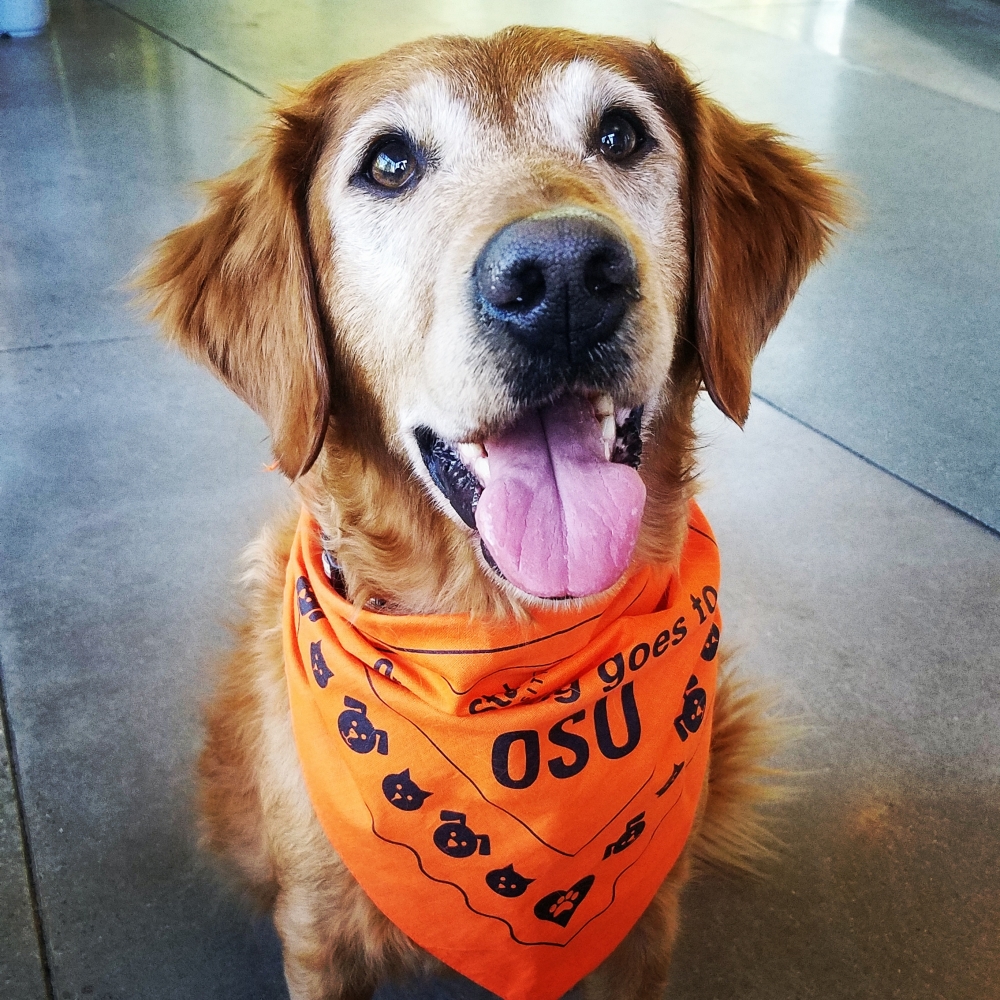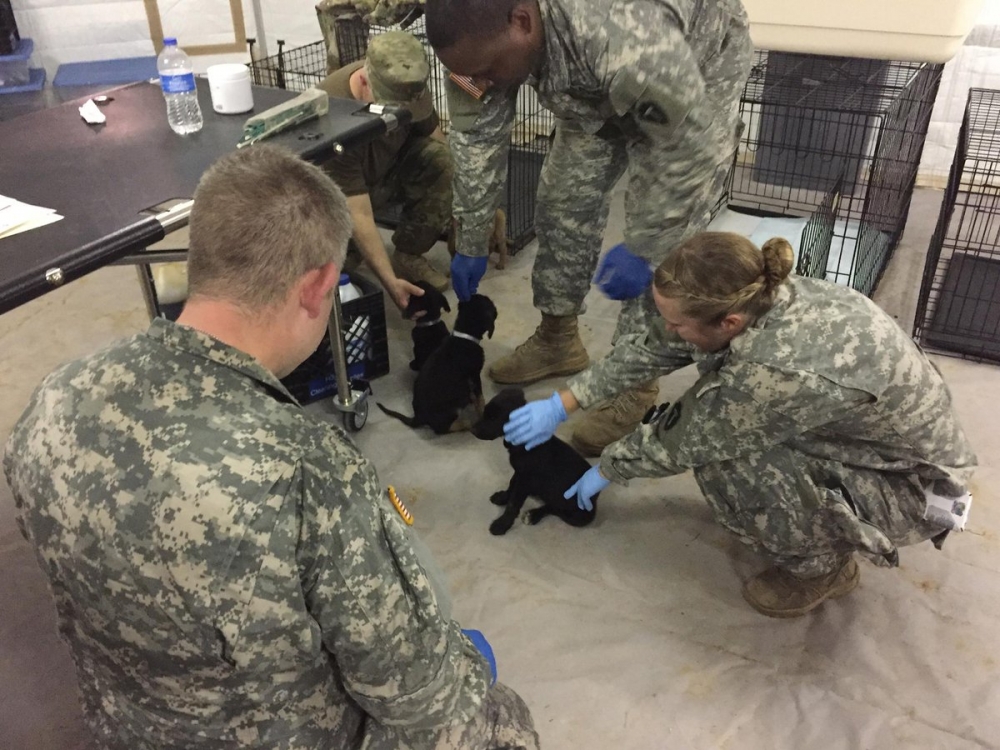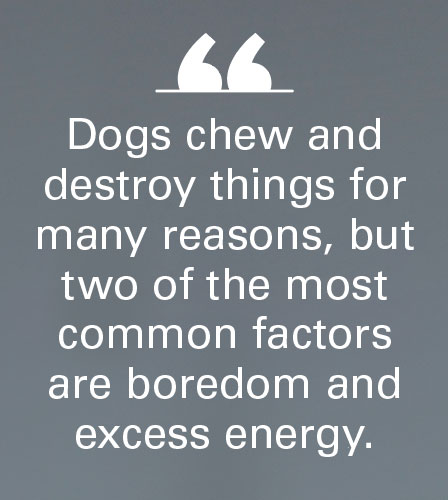- Dog CareDog LifeCommunity
- Photo Contest
Photo Contest- Giveaways
Getting An Emotional Support Dog
What Is An Emotional Support Dog?
An emotional support dog is a pet that provides comfort and relief to those with disabilities. These dogs aredifferent than service dogs because they do not perform tasks for their owners. Instead, they provide security and love which relieves at least one symptom of their owner’s disability. These animals are often used to help those with anxiety, mental or emotional conditions.
Service Dogs vs Emotional Support Dogs
It is important to understand the difference between service dogs and emotional support dogs, as they are very different. A service dog is categorized as medical equipment for their owners. They are trained specifically to perform certain tasks their owners cannot complete on their own. Some examples are seeing eye dogs that help their owners cross the street or dogs that help owners do chores around the house. Service dogs are permitted to go places most pets cannot go because their owners need their help.
These animals are prescribed to owners who need emotional support and stability. These dogs do not perform tasks for their owners, but simply improve their quality of life through emotional connection and support. Since the dogs are not required to perform tasks, there is no specific training needed. Unlike service dogs, these animals are not considered to be medical equipment but laws are in place that allows these animals to be with their owners. The Air Access Carrier Act allows support dogs to fly with their owners at no extra charge. Owners must have written proof from a licensed physician or mental health professional to qualify for this benefit. The Fair Housing Amendment Act of 1988 helps emotional support animal owners qualify for pet-free housing at no extra charge. No other entities such as motels, libraries, theaters or public areas must abide by these laws. In these areas, these pets are considered pets and have no additional rights.
What Are The Qualifications For Getting An Emotional Support Dog?
Those who want an emotional support must legally qualify to do so. A licensed mental health professional such as a psychologist, therapist or psychiatrist must write a prescription letter in the proper format. The letter must state the name of the patient, that they are under the care of the practitioner and the type of disability that exists. In addition, the letter must state how this disability negatively affects at least one activity in life. The practitioner must also clearly state they are prescribing an ESA as an essential part of mental health treatment. In order to be legal, this letter must be written on the practitioner’s letterhead and dated. The license number of the professional and the state in which it was issued is also required.
Serious mental or emotional health conditions are considered to be disabilities. You may qualify to obtain an ESA if you have one of the following conditions that depression, anxiety, post-traumatic stress disorder, seasonal affective disorder and panic disorder.
• At Touch ESA, our mission is to raise awareness of the benefits of emotional support dogs and to provide an easy, fast, and affordable online assessment to determine ESA eligibility and a properly formatted prescription letter for housing and travel purposes. Live and travel anywhere with your dog by your side. For more information or to take a free assessment visit www.touchesa.com or call 414-807-8934.
JJ’s Journey: A Story of Heroes and Heart
JJ is a 7-year-old golden retriever female who is a Therapy, Hospice, and Crisis Response dog. She’s prone to sassiness and constantly in search of bacon, while often confused by those who meet her with a male Irish Setter of unknown origin, despite wearing flowers on her collar. Tracy Calhoun has been a hospice nurse for 23 years and JJ works three days each week alongside her at an inpatient hospice facility, providing comfort to patients, families, staff, and volunteers. In 2015, a short video of JJ’s work at hospice went viral, sharing the power of the human-animal bond with people across the world.
End of life is a difficult topic for anyone to discuss, and stories including animals can be a more non-threatening bridge to the conversation that everyone will eventually need to face. On JJ’s social media venues, Tracy balances heart wrenching stories with more lighthearted moments in a way to reach out and support not only families we have served in hospice, but the general public. JJ also is a Crisis Response K9, responding to national and local crises offering support and comfort.
In 2016, Tracy was approached to write a book of stories involving JJ, her hospice work, and day to day life. These include stories ofwork and play that make you smile, laugh, and cry. "JJ's Journey: A Story of Heros and Heart" was released in October 2017.
It was during the time of writing these stories that JJ was diagnosed with lymphoma. Even during treatment, she has taught everyone she touches how dogs embody the concept of living in the moment. No one has told her she has a life limiting disease, so she continues to live life with zest and work at her second home. Her motto has become “Barke Diem,” a dog’s take on Carpe Diem, meaning seize the day. She has inspired thousands to take on the same approach to day to day life, no matter the victories or challenges.
Click here to learn more about JJ's incredible journey
Unfortunately, on December 29, 2017, JJ lost her battle with Lymphoma. While Tracy and so many others are heartbroken, her incredible legacy lives on with donations in her name to The Morris Animal Foundation. The Morris Animal Foundation is a non-profit organization that invests in science that makes the world a brighter place for animals and those who love them. Click here to donate in JJ's name.
The Cause of Tear Stains
Ever wonder what causes the reddish-brown stains beneath a dog's eyes, especially noticable in light coloured or white dogs? Called tear stains, this discolouration is a result of excessive tear production. There are a number of factors contributing to excessive tearing. Eyelids that turn inward can cause eye irritation that leads to tearing. Brachycephalic (or short-nosed) dog breeds, such as Maltese, Pekingese, Shih-tzus, and Pugs, are often prone to eye tearing due to shallow eye sockets and hair growth in the skin folds surrounding the eyes. Other breeds, including Poodles and Cocker Spaniels are simply predisposed to blocked tear ducts.
If these stains develop rapidly or your dog seems to be in discomfort, make sure to check with your vet to rule out any causal problems that can be addressed. For example, eye infection and glaucoma can be treated; hair near the eyes can be carefully trimmed very short. For eyelid and eyelash problems, you may wish to investigate surgical options depending on the discomfort it is causing your dog. For shallow eye sockets causing tearing, however, there is nothing that can be done; you’ll simply want to reduce skin irritation and coat discolouration. To do so, try Angel Eyes’ awesome Natural Line. Their Gentle Tear Wipes are designed for daily use and are fantastic for cleaning the eye area and eliminating staining, while their Natural Soft Chews blend natural antioxidants including cranberry powder, Oregon grape root, and marshmallow root to prevent inflammation in your dog’s eyes. Find them at angelseyesonline.com.
Help! My Dog Is Marking In the House
Q: “I recently adopted an adult Basset Hound who seems to have an ingrained marking habit. Though he will occasionally pee in the house (most of the time will ask to be let out) he will mark in the house on a daily basis if not monitored. I have experience housetraining dogs but what do you do about marking?” —Frustrated in Fredricksburg
A: Male dogs lift their legs and urinate to mark territory. This behaviour is ingrained in canine DNA. Pheromones in the urine give other dogs information about the one who left the mark. If you watch closely the next time you’re at a dog park, you will very likely see male dogs trying to out-mark each other by urinating higher and higher on a vertical surface. Understandable though that might be, having a dog leave his mark around your house is a whole different story. But not to worry! There are things you can do to keep your house pee-free.
You didn’t mention whether your Basset boy is neutered. Neutering male dogs sometimes puts a stop to urine marking, although it is not a guaranteed cure. The other thing that must be mentioned is management. You said he marks “if not monitored,” so the easy solution is to make sure he is monitored. Of course, that’s easier said than done. So, during times when you cannot watch him, crate him. If he is not accustomed to a crate, take the time to acclimate him to it gradually by feeding meals and giving treats inside with the door left open, and eventually closing him in for short periods when you are home. Giving him something wonderful to chew on is helpful as well. When you do actually leave him home alone crated, potty him first, and make sure he is not left crated for longer than three to four hours at a time.
I’m curious whether the marking occurs in one particular location or in various areas of the house. Let’s say it happens in one spot—on the side of your couch, for example—and you clean and deodorize it each time. From your dog’s point of view, he’s gone to the trouble of putting his scent there, and for some strange reason it just keeps disappearing! What’s a dog to do but reapply at the first opportunity? If this is the case in your home, the next time you’ve finished cleaning up the actual urine, try this trick: Take a rag and wipe it around your dog’s rear, where the anal glands are located. Then, wipe the rag on the spot where he tends to mark. Nothing offensive to humans will be left, but it will leave the scent of your dog. Therefore, your dog would have no reason to keep marking there. Pretty nifty, eh?
Another consideration is whether you have had dogs in the house previously. Sometimes the odours of other dogs linger in the carpeting, on couch cushions, and in other places. If that is the case, it may be that your dog is trying to mark over that scent. Getting your carpet, cushions, and wherever else your dog is marking professionally cleaned could solve your issue.
If, despite your best efforts, you absolutely cannot change your dog’s behaviour and crating is not an option, you could manage the situation by using a belly band. A belly band is a narrow strip of soft, stretchy fabric that Velcros closed. It is placed around a dog’s waist and contains an absorbent material. This, of course, prevents dogs from urinating or marking. We recommend trying the belly bands by Pet Parents (petparentsbrand.com)—they have different sizes and colors to fit your dog and lifestyle. If you do choose to use a belly band, be sure to remove it periodically to take your dog outside to allow him to urinate.Nicole Wilde is an award-winning author of ten books on canine behaviour. Her books, seminar DVDs, and Wilde About Dogs blog can be found at nicolewilde.com.
‘Make the Days Count’: BuddyRest Partners with Grey Muzzle to Provide Hospice Care for Senior Dogs
Every senior dog deserves the chance to live out their final days in comfort and surrounded by love. Yet many senior dogs are not that fortunate. Grey Muzzle's hospice fund is changing that. BuddyRest is pleased to announce a $2,500 matching donation to support The Grey Muzzle Organization's 'Make the Days Count' campaign which is raising money to support desperately needed hospice programs for senior dogs who have only months, weeks, or days to live.
"We envision a world where no old dog dies alone and afraid," says Lisa Lunghofer, Ph.D., executive director of The Grey Muzzle Organization, "and this campaign is moving us a step closer to realizing that vision." As part of the campaign Grey Muzzle is sharing hospice stories and providing information on end-of-life care. The goal is to increase awarenes of hospice-related resources and raise $5,000 to help make hospice a reality for senior dogs in need.
BuddyRest is delighted to partner with The Grey Muzzle Organization and support this campaign. Trevor Crotts said…"It's easy for us to partner with such a tremendous organization with a cause close to our hearts. We are happy to provide amazing support for Senior dogs with our orthopedic beds, in addition to supporting high impact organizations like Grey Muzzle".
About BuddyRest
Since 2011, BuddyRest has utilized innovative design and top-quality construction to develop products that improve the lives of animals and make life easier for pet parents. Their award winning dog beds are designed to eliminate painful pressure points and are Veterinarian Recommended to promote joint health in all animals.
About The Grey Muzzle Organization
Since it began about ten years ago, The Grey Muzzle Organization has awarded more than $1 million in grants to 108 nonprofit organizations in 32 states. These grants provide senior dogs with medical and dental care, adoption, foster and hospice programs, and assistance to prevent them from being surrendered to shelters, among other lifesaving programs.
To donate or learn more, please visit greymuzzle.org and buddyrest.com
Puppies Rescued By Texas A&M ‘VET’ Team Provide Relief For Responders
While the Texas A&M University Veterinary Emergency Team (VET) has been deployed to a variety of locations along the Texas Coast in response to Hurricane Harvey, the rescued puppies receiving VET services have also served a dual role, providing “puppy therapy” for many of the responders.
“Over the course of our deployment, when we have rescued puppies that have been examined and treated and are awaiting transport to a shelter, we have often found that military personnel will just happen to stop by to chat with us, citing that they’ve heard we have puppies,” VET Public Information Officer Jennifer Gauntt said.
“These responders are on the front line, seeing the worst as they work in communities devastated by the storm. When they interact with these puppies, for a moment, they are able to forget all of the destruction, and occasionally death, they have encountered. The smiles that spread across their faces when they see and hold the puppies show us the powerful effect animals can have on people who have been working in the field.”
Studies have shown that exposure to pets can alleviate stress, reduce anxiety and depression and lower blood pressure in people. Sgt. Ty Wenglar, Texas A&M Class of ’96, Charlie Company 949 BSB, Texas Army National Guard, expressed his thanks to the VET team for providing much-needed relief.
“Puppies embody the very essence of what home is. They are always loving, always playful, always happy to see you. Most of us have now been away from home for almost two weeks, with the expectation of another week or more in the field,” Wenglar said. “Getting to play with Texas A&M VET’s puppies gave us all a brief respite from the relief effort and few moments of ‘home.’”
8 Reasons Why Social Media is More Important than Ever
Social media was once an iffy area to venture into for many business. Many companies asked themselves whether it was even worth the time and resources or was it really a viable option. Well that ship has sailed and it has become increasingly important to really push your way through the online social media space.
There are a variety of reasons why you should do it now rather than later and here are a few to think about:
1. Everybody Is Doing It
The reality is that if the older generations are starting to use social media the impact it has already made on younger generations is completely irreversible. Social media has become a part of everyone’s life and it is something that influences their daily life. Social media has played a big role with how people interact with each other and it is something that is not slowing down anytime soon.
2. People like Branding
This is just a reality; people enjoy being part of a business that brands themselves proactively. Studies have shown that customers in certain verticals would rather give their money to a business with an active Facebook fan page rather than without. People tend to get that warm and fuzzy feeling when they see a business building a community for themselves.
3. Distance Yourself from the Bad Apples
The internet is growing daily and with that growth comes bad apples. One way to distance you from the bad apples is by starting a community and growing a following in the social space comprised of your core audience. No bad apple is going to take the time to grow a quality online community to build their brand online. This is not something that is going to slow down and the power and strength a community can drive to a growing a brand is amazing.
4. Community Is Everything
Everything online has really surrounded the concept of building a community or a group of cheerleaders that can vouch for your business. People like to feel like they are a part of something unique and special and that usually comes from being a part of a community. Community strength is a very powerful branding force that can significantly grow a business on and offline.
Social media is an amazing way to grow an online brand in leaps and bounds it simply takes creativity, passion and consistency to keep things moving in the right direction. If you have not yet entered the social media space take the time to start thinking about a plan to enter the space and start building your online community.
Regardless of the industry in which you are operating, social media should be an important part of your advertising and public relations strategy. Every business should have some kind of social media marketing platform in place, and it should be engaged at least once a week, or better yet, on a daily basis.Interacting on social media several times a week can significantly increase the leads being directed to your website at little to no cost.
5. Expand Potential Customer Base Quickly
Statistics show that nearly 1 in every 5 minutes spent online is on some kind of social media network. The younger generation particularly communicates more and more via social media, and older internet users are also becoming increasingly involved with it. With instant access and sharing capabilities, social media marketing blows cold call sales out of the water by reaching more people and making more contacts faster. You can build strong relationships with both current and potential customers by commenting on their posts and offering them coupons or discounts on your products and services.
6. Other Benefits
There are a number of other benefits to using social media to promote your business such as:
- Helping potential customers who are surfing the Net find your website faster
- Increasing traffic on your website and generate more online sales
- Enabling you to find more leads and potential customers that you can quickly and easily contact
- Assisting you in targeting the right audience for your products and services
- Staying ahead of your competition by making the most of every marketing opportunity
7. Don’t let your Competitors Beat You
Try searching out your competitors on the web to discover whether or not they have a social media presence. Check sites like Facebook and Twitter to see how many followers your competitors have for their businesses. If you find that other businesses in your industry are actively engaging in social media marketing, you most likely need to get active as well. You do not want your competitors to leave you in the dust, especially when social medial is free. A simple Facebook or Twitter page can attract hundreds and even thousands of additional people to your website without you having to spend a dime.
8. Sell on Facebook
Your website service provider can help you find out how to embed a shop code onto your Facebook page. Integrating a virtual shop into your Facebook page can really boost your sales. A one-stop shop like Facebook, where your fans can communicate, learn about your latest products and services, and actually make a purchase is taking convenience to a whole new level. Your customers will be thrilled, and you can rack up more sales very quickly.
It is almost always wise to stay abreast of the latest marketing and advertising techniques in your industry. Many people enjoy communicating via social media or just surfing the web and learning about trends and new ideas. A savvy business owner will find a way to communicate with the large volume of people using Facebook, Twitter and other social sites. Social media marketing is no longer the wave of the future. It is here now.
This article originally appeared on Brandignity.com
Destructive Chewing
Q: My six-month-old Weimaraner puppy is a holy terror, destroying EVERYTHING. She’s even chewed the couch and the edge of the stairs. She destroys anything she can get her paws on whether we’re home or not. What can I do about this? Please help!
A: Your girl sounds like a happy, healthy Weimaraner pup to me! On the positive side, she’s got lots of that fabulous puppy energy. Now we just need to find ways to focus it on things other than your furniture and prized possessions. Since you mentioned that she’s destructive whether you’re home or away, let’s break the solution down into two parts: there and gone.
First, let’s discuss when you’re gone. There’s not much you can do about destructive behaviour if you’re not there, so it’s time for some tried and true management techniques. Is your girl crate trained? If so, great! If not, check out moderndogmagazine.com/crate-training for how to acclimate her to a crate. Be sure she’s gone potty and is well tired out from exercise before crating her. You can leave her crated up to three to four hours while you’re away. If you are going to be gone longer, have someone come in every few hours to exercise and potty her. The same applies if you choose to have her gated in the kitchen or another room instead of the crate. Just make sure there’s nothing in the area she can destroy.
Dogs chew and destroy things for many reasons, but two of the most common factors are boredom and excess energy. Regardless of where you leave your pup when you’re gone, she should have a chew item that’s going to keep her busy and be more appealing than her surroundings. Chew items can also be part of the solution when you’re at home, as they provide an acceptable focus for excess energy and can give you a short break from watching your dog like a hawk!
Different chew items appeal to individual dogs, but a stuffed Kong is one of my all time tried and true favourites. (Some Kong stuffing recipes include a high-quality wet dog food, canned pumpkin, leftover chicken (boneless, of course!) and mashed potatoes, or peanut butter. Tip: freezing a stuffed Kong will keep your dog busy even longer!) There are also many types of balls and other dispensers that can be filled with kibble or treats, which then have to be knocked around to get at the goodies. Sometimes these more “active” type dispensers are more enticing to active dogs who have a hard time lying still to chew.
Two other parts of the puzzle are mental stimulation and physical exercise. Chew toys and dispensers offer some mental stimulation, but you can provide your pup with even more opportunity to use her brain. Training, particularly clicker training, which teaches dogs to figure out what you want and to offer behaviours, is one of the best ways to provide mental stimulation. And those wonderful learned behaviours will also make your life easier! In addition to training, there are puzzle toys that require dogs to paw and nose at various sliders and levers in order to get to hidden treats. And, if you want to earn Mental Stimulation extra credit, take your pup to a K9 Nosework class. Nosework provides excellent mental stimulation for dogs of all ages. No time for class? Pick up a book like Fun Nosework for Dogs by Roy Hunter that teaches you how to set up nosework games at home.
Exercise is all-important when you have an active, high-energy pup. Most owners drastically underestimate the amount of exercise their dogs need. They believe, for example, that a 15-minute potty walk is sufficient. Not even close! Your pup needs long walks that allow him to stretch his limbs and—how great is this?—also provide mental stimulation in the form of sniffing and exploring! Hiking is a great way to accomplish this. If you are not in an area where hiking is possible, go for long walks around your neighbourhood exploring together. Vary your path periodically to keep things interesting.
Lastly, don’t undo all of your good work by feeding a low quality food. Foods that have lots of corn and other fillers rather than quality ingredients can make a huge difference in dogs’ behaviour. As a trainer, many times I have seen owners do nothing but switch a dog to a better quality food, and the hyperactive and destructive behaviours were greatly lessened.
If you do catch your pup in the midst of puppy redecorating, interrupt the behaviour with a sharp verbal “Eh-eh!” Once you have her attention, lead her away from the area, ask for a simple behaviour such as a sit or down, and then reward her with a proper chew item. The reason to incorporate asking for a behaviour between the interruptor and the reward is so that your pup does not come to equate chewing with being rewarded.
In summary, ensure that your puppy is eating a high quality food and being given proper chew toys, is getting lots of physical exercise and mental stimulation, and is being properly managed whenever you’re away. And, of course, be vigilant when you are at home. If you do these things consistently, you will not only have less destruction, but a healthy, happy, well-adjusted pup who’s gone from “holy terror” to “Holy smokes, what a great dog!”
Nicole Wilde is an award-winning author of ten books on canine behaviour. Her books, seminar DVDs, and Wilde About Dog blog can be found at nicolewilde.com.
How to Choose the Right Shelter Dog for You
A new pet is on your radar, and with all the abandoned dogs out there looking for a home you’ve decided to save a shelter hopeful instead of going through a breeder. That’s excellent. Millions of dogs in shelters everywhere anxiously await someone just like you. Luckily, shelters aren’t depressing places like the dog pounds of yore. But how do you choose the right shelter dog?
First off: is a dog, whether from a shelter or a breeder, the right pet for you?
Bringing a new dog into your home is a major undertaking and commitment. Training, socialization, play, exercise, and simple camaraderie are essentials for such a group-minded, gregarious animal that doesn’t fare well left on his own. If work keeps you away from home for long periods and if your family keeps similar hours, bringing a new dog into the home might be difficult. Cost should also be considered. Veterinary and food costs, beds, crates, leashes, toys and other essentials add up over a dog’s lifetime. The initial adoption fee can range anywhere from $50 to well over $250, depending on the dog and the shelter and whether or not vaccinations and a spay/neuter are included—a steal really as these rates are often subsidized to encourage adoption and as such are less than the shelter’s actual costs.Puppy? Young adult? Senior? It’s all about your lifestyle
If you feel confident in taking on the challenge of a new dog, move on to the next step: determining what type of dog you are looking for. Do you want an eager, precocious puppy or are you open to adopting a young adult or even an older dog? Though adorable and quick to learn, puppies need lots of love and attention and must be housetrained and taught basic obedience. For at least a year, you’ll need to be a doting dog “parent.” A young adult dog, however, might already know some basics and have decent housetraining skills (though he will still need to be acclimated to your home). You’ll also have a better idea of what your new dog will look like as an adult and how large he will grow. You might even take a chance on an older rescue. These mature pets can be a great choice for those with less spare time on their hands. Personality and physical stature are set, so there are no surprises. Housetraining is often stable, and the energy of youth has abated into a more laid-back countenance. If they’ve made it this far, chances are they are good dogs simply dealt a tough break.Breed Type
You can find both purebred dogs and mixed breed mysteries at a shelter, though many purebreds are plucked from shelters by breed-specific rescue groups to assist in their re-homing; if you have a specific breed in mind and there aren’t any currently housed by your local shelter, look up a local breed-specific rescue group dealing with your desired breed. They’ll likely have many adoption candidates for you to consider. Considering a mixed breed cutie? You can make fairly accurate determinations as to their personality by their appearance, size, demeanor, and what general “breed type” the dog is. Walk through any shelter and you’ll see Pit Bull and retriever mixes, shepherd and Rottweiler crosses, Chihuahua/terrier mixes, and other fairly identifiable blends of purebred animals. Want a big, energetic running pal, a couch potato, or a little foot warmer? If your home is small, for instance, or if you are a senior citizen, you might choose a lower energy older pet or a petite breed. But if you have a large home with a fenced yard (some shelters may insist on this) and you intend to take your dog on lots of walks or jogs, you could opt for a more athletic pet. As a general rule, choose a breed type that matches your own level of energy. If you are the athletic, lively type, pick an active dog, like a pit cross, terrier mix, or a herding or retriever mix. If you are more sedate, choose a calmer breed type, like a Greyhound or Whippet cross (yes, they are couch potatoes), Chihuahua mix, Mastiff or toy spaniel cross, or even a Maltese or Toy Poodle type. As you can see, size means less than breed type when it comes to energy levels.Gimme Shelter
The next step is to find that special dog. That means searching local shelters and making a decision. Whether you use an online service like petfinder.org or adoptapet.com, think about finding shelters or rescue groups located reasonably close to your home to make multiple visits easier. Commit to visiting several before making a decision! This is often the hardest part of the process; we all have a soft spot for hard luck cases after all. Just do your best to remove emotion from the equation.Any shelter you consider should have an adoption return policy, allowing you to bring a dog back. A thirty-day trial period is common. Some will refund your money should it not work out, while others will give a return voucher allowing you to adopt another animal. All should either spay/neuter the dog before you take him or her home or at least give you a discount neuter voucher for a local veterinarian. And all adopted dogs should receive appropriate vaccinations before they leave. Many shelters will hold a dog for you for at least a day or more if you need time to think it over.
When at the shelter, pay attention with all your senses. Does it look and smell reasonably clean? Ideally, shelter employees should be helpful, knowledgeable, and compassionate. The staff should properly vet you regarding your potential to provide a dog with a safe home but shouldn’t be rude or overly critical. A good shelter sets a balance between finding a capable new home for their dogs and knowing that, without that new home, a good dog could be euthanized.
The shelter should temperament-test all dogs before showing them to the public to weed out sick, aggressive or emotionally unstable animals. If you see significant behavioural problems, think about another shelter.
Find That Dog
On a first visit to a shelter, consider leaving your children home, if you have them. This initial visit should be unemotional and guilt-free; the “love at first sight” that happens to kids (and indeed some adults) can influence what should be all business.Once you have interacted with a few potential winners, you can bring the children for a second visit. Do a “first run” through the kennel and watch how the dogs interact with people. Do the breed types you’re interested in show friendly interest and a desire to be petted, or are they slow to warm, skittish, or hiding in a corner? Do they appear healthy and fit, or are their coats dull and sparse and their bodies thin? (Keep in mind a good grooming can do wonders.) Are they interacting peaceably with their kennel mates, or growling at or shying away from the other dogs? Though barking is common among kennel hopefuls, incessant barking, especially toward human visitors, is not a good sign. Tails should be wagging and ears erect. Do keep in mind though that a shelter is a very stressful environment for dogs, and that their personality can change greatly once they’re out of their kennels.
Once you’ve made your first walk-through, focus in on dogs you found interesting and good-natured. Make eye contact and coax the dog over (no treats yet as it might prompt a food fight). Once given hands-on access, pet the head first, then casually move to the back and chest. Hopefully, the dogs will welcome the attention. Any skittishness, cowering, growling or nipping is a sign to move on. Stay calm and confident and avoid excess emotion or physicality.
After you’ve narrowed it down to two or three dogs, ask permission to take each out on a leash, to get a feel for their personalities outside of the chaotic kennel environment. Pulling is to be expected, but any wild over-the-top behaviour such as leaping, bucking, nipping, or lunging at people or other dogs should move you on to the next hopeful. If possible, see how each dog behaves around other leashed dogs. Look for friendly greetings, wagging tails, and a playful demeanor.
If all goes well, see how each dog takes a treat. Dogs older than a few months may know basic behaviours such as “sit” or “shake,” so ask for a quick sit and see what happens. Then, to check for food guarding issues, drop a few treats onto the ground near the dog then attempt to pick one up. If the dog stays calm and friendly, that’s great. But if it barks, growls, nips, or shows any hostility, move on to the next hopeful.
Second Visits
Ideally, you should visit at least two shelters and compare the dogs you have seen and liked. Keeping a log is a good idea. Then, it’s time to take your friends or family with you for a second look at the three or four hopefuls. Repeat the same on-leash walk and spend as much time as allowable. If you have an established, older dog at home, bring him with you on these visits to see if the two get along. Be sure to get the permission of shelter personnel before bringing your dog in, of course. If your resident dog has a history of dog aggression, though, it’s probably not prudent to obtain a second.Going Home
The entire process can take over week so stay patient and avoid impulsive decisions. If you do decide to take a lucky dog home, you’ll need to purchase the appropriate equipment—leash, collar, ID tag, food and water bowls, a bed, a crate perhaps, and a few toys. The shelter will most likely provide you with enough food to last a week or so; you’ll need to decide if you’ll keep the dog on that same food or switch her over to one of your choosing. If so, make the change slowly, over a week or more, gradually adding more of the new food and reducing the old. The slow switchover will help prevent diarrhea, which often occurs when a dog switches food too quickly.Schedule a visit to your veterinarian within a week or so to ensure good health. Shelter dogs can sometimes have worms, fleas, bordatella (“kennel cough”), or a host of other concerns, so don’t delay on this step (they should have been fully vet checked at the shelter, de-wormed and de-flea-ed but a check up is still a good idea). And be sure to enroll in a basic obedience class to start things off right. Some shelters even provide classes or will give you a discount coupon for a local training facility. If not, ask them or your veterinarian for a recommendation.
By doing your homework, staying unemotional, and being patient, you’ll end up with a loyal new friend, one who will appreciate the new lease on life you’ve provided more than you’ll ever know.
Dogify Your Inbox
Sign up for the FREE Modern Dog Magazine newsletter & get the best of Modern Dog delivered to your inbox.
"*" indicates required fields
By clicking the arrow, you agree to our web Terms of Use and Privacy & Cookie Policy. Easy unsubscribe links are provided in every email.









 Dogs chew and destroy things for many reasons, but two of the most common factors are boredom and excess energy. Regardless of where you leave your pup when you’re gone, she should have a chew item that’s going to keep her busy and be more appealing than her surroundings. Chew items can also be part of the solution when you’re at home, as they provide an acceptable focus for excess energy and can give you a short break from watching your dog like a hawk!
Dogs chew and destroy things for many reasons, but two of the most common factors are boredom and excess energy. Regardless of where you leave your pup when you’re gone, she should have a chew item that’s going to keep her busy and be more appealing than her surroundings. Chew items can also be part of the solution when you’re at home, as they provide an acceptable focus for excess energy and can give you a short break from watching your dog like a hawk!